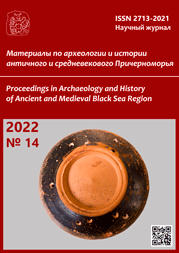Сравнение китайского и монгольского опыта отношений с Восточной Римской империей
The Comparison of Chinese and Mongolian experience in relations with the Eastern Roman Empire
Author(s): Daniil Shulga, D.A. Iushchenko, N.M. TernovSubject(s): History, 13th to 14th Centuries
Published by: Нижневартовский государственный университет
Keywords: Byzantium; Eastern Roman Empire; Nanbeichao; Sui; Tang; House of Hulagu; Great Silk Road; solidi; bracteates; Yuan empire; Azak;
Summary/Abstract: The purpose of the study is to compare the history of relations between the early China’s medieval states and the Eastern Roman Empire with Mongols’ policy in relation to the Roman states, and to identify the similarities. The most important sources include the archaeological materials (coins and their imitations, art objects from the territory of China and Mongolia), epigraphy from the Yuan Empire Nestorians burials, Chinese narrative sources data about the “Great Qin and Fulin” as well as references to Mongolian relations with the Roman states work of medieval authors from Asia Minor. Despite the active relationship of the Chinese kingdoms and empires (as well as their northern neighbors, herders) with the Eastern Roman Empire in the early Middle Ages this topic is not widely studied in Russian literature. Meanwhile, on the basis of archaeological and narrative sources (and their mutual criticism) it can be concluded that there are numerous parallels in perception of Byzantium, on the one hand, by the Chinese, and on the other, by the Mongols. Probably one of the reasons for Chingizids very tolerant attitude towards the Romans was the Nestorianism spread (traditionally associated in China with the “Great Qin”, that is the Roman Empire and its successors) north of the Yellow River (including in the Yuan Empire in the 14th c.). Both Chinese in the era of Nanbeichao, Sui and Tang, and the Mongols in the 13th — 14th cc. were (with a few exceptions) positively disposed towards the Eastern Roman Empire (and its fragments like Trebizond and Nicaea). At the same time, of course, due to the common border and Chingizids’ high military potential the latter acted as the “senior” side in this “alliance”.
Journal: Материалы по археологии и истории античного и средневекового Причерноморья
- Issue Year: 2022
- Issue No: 14
- Page Range: 331-346
- Page Count: 16
- Language: Russian

